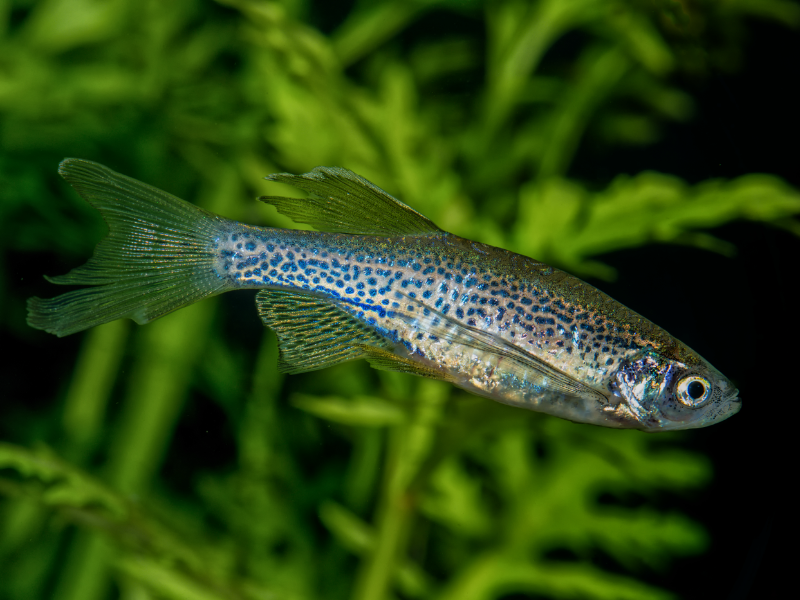Danio rerio
Zebrafish

Wissenschaftliche Klassifizierung
Schnellstatistiken
Aquarienbau-Informationen
Über diese Art
Grundbeschreibung
Detaillierte Beschreibung
Danio rerio, allgemein bekannt als Zebrafisch, ist ein dynamisches und widerstandsfähiges Mitglied der Familie der Cyprinidae (Karpfenfische), das aus den Süßwassersystemen Asiens stammt. In seinem natürlichen Lebensraum ist er in mittelstark fließenden Bächen, Reisfeldern und Teichen zu finden, was auf seinen Bedarf an ausreichender Wasserbewegung und Sauerstoffversorgung in einem Aquarium hinweist. Seine torpedoförmige, spindelförmige Körperform ist eine klassische Anpassung an das Leben als schneller, aktiver Schwimmer, die es ihm ermöglicht, Strömungen mit Leichtigkeit zu durchqueren. Dieses hohe Aktivitätsniveau wird durch einen hohen Stoffwechsel angetrieben, was eine tägliche Fütterung mit einer abwechslungsreichen, omnivoren Ernährung erfordert. Eine Kombination aus hochwertigem Trockenfutter (Flocken, Pellets) und regelmäßigen Gaben von Frost-, gefriergetrocknetem oder Lebendfutter stellt sicher, dass er die ausgewogene Ernährung erhält, die für optimale Gesundheit und Vitalität erforderlich ist.
In Gefangenschaft ist sein Sozialverhalten eines seiner prägendsten Merkmale. Es sind Schwarmfische, die in Gruppen gehalten werden müssen, um sich sicher zu fühlen und ihr faszinierendes interaktives Verhalten zu zeigen. Eine unzureichende Schwarmgröße kann zu Stress und Schreckhaftigkeit führen. Sie bewohnen vorwiegend die oberen und mittleren Schwimmzonen eines Beckens, daher ist offener Schwimmraum in diesen Bereichen wichtig. Diese Fische sind für ihre Fähigkeit bekannt, aus unabgedeckten Becken zu entkommen, ein Verhalten, das die Wichtigkeit einer sicheren Aquarienabdeckung unterstreicht. Trotz ihrer hohen Aktivität wird angenommen, dass sie eine geringe biologische Belastung (Bioload) haben, was bedeutet, dass sie für ihre Größe eine relativ geringe Menge an Abfall produzieren. Ihr hoher Stoffwechsel und der tägliche Fütterungsplan tragen jedoch immer noch zur gesamten Nährstoffbelastung bei, was eine konsequente Beckenpflege und Filtration erfordert. Ihre Toleranz gegenüber einem breiten Spektrum von Wasserhärte- und pH-Werten macht sie zu einer nachsichtigen Art für Hobbyisten, aber stabile Bedingungen sind für die langfristige Gesundheit immer vorzuziehen. Aufgrund ihres friedlichen Wesens lassen sie sich gut in Gesellschaftsaquarien mit anderen kleinen, nicht-aggressiven Fischen integrieren.
Wissenschaftliche Beschreibung
Danio rerio ist ein kleiner Cyprinide mit spindelförmigem Körper, der in den Süßwasser-Ökosystemen der Himalaya-Region und Südasiens heimisch ist. Als Mitglied der Familie der Cyprinidae ist er taxonomisch mit anderen Karpfen und Elritzen verwandt. Seine Morphologie ist stark an eine pelagische Lebensweise in seinen heimischen Lebensräumen angepasst, zu denen Bäche und langsam fließende Flüsse gehören. Der stromlinienförmige Körper minimiert den Wasserwiderstand und ermöglicht so schnelles, ausdauerndes Schwimmen, ein charakteristisches Verhalten der Art. Physiologisch weist D. rerio eine hohe Stoffwechselrate auf, was seinem 'sehr aktiven' Aktivitätsniveau und seinem mittleren Sauerstoffverbrauch entspricht. Er ist ein Allesfresser (Omnivore), der sich in freier Wildbahn von einer breiten Palette von Nahrungsquellen wie Zooplankton, Insekten und Algen ernährt. Diese ernährungsphysiologische Plastizität trägt zu seinem ökologischen Erfolg bei.
Die Art zeigt eine bemerkenswerte Toleranz gegenüber einer Vielzahl von hydrochemischen Parametern und gedeiht sowohl in leicht saurem als auch in alkalischem Wasser sowie über einen beträchtlichen Gradienten der Wasserhärte. Obwohl er ein reiner Süßwasserfisch ist, kann er sehr geringe Salzgehalte tolerieren. Seine Fortpflanzungsstrategie ist die eines Freilaichers, eine gängige Methode unter Cypriniden, und er hat eine hohe Reproduktionsrate, die zur Stabilität seiner Population beiträgt. Die Weltnaturschutzunion (IUCN) hat D. rerio als 'Nicht gefährdet' (Least Concern, LC) eingestuft, was darauf hindeutet, dass es sich um eine weit verbreitete und häufig vorkommende Art handelt, die derzeit keinen wesentlichen Bedrohungen für ihr Überleben in freier Wildbahn ausgesetzt ist. Über seine Rolle in seinem Ökosystem und in der Aquaristik hinaus ist Danio rerio ein führender Modellorganismus in der wissenschaftlichen Forschung, insbesondere in der Genetik, Entwicklungsbiologie und Toxikologie, aufgrund seiner schnellen Entwicklung, seiner transparenten Embryonen und seiner genetischen Ähnlichkeit zum Menschen.
Zuchtbeschreibung
Die Vermehrung dieser Art im Heimaquarium gilt allgemein als unkomplizierter Prozess, was sie zu einer ausgezeichneten Wahl für Hobbyisten macht, die neu in der Zucht sind. Diese Fische sind Freilaicher, was bedeutet, dass die Weibchen ihre Eier in die Wassersäule abgeben, die dann von den Männchen befruchtet werden. Sie zeigen keine Brutpflege und fressen aktiv ihren eigenen Laich und ihre Brut, was ein spezielles Zuchtbecken erfordert, um einen erfolgreichen Ertrag zu gewährleisten. Die Unterscheidung der Geschlechter ist bei geschlechtsreifen, gut konditionierten Tieren am deutlichsten. Weibchen haben typischerweise einen größeren, runderen Bauch, was ihnen eine fülligere Körperform im Vergleich zu den schlankeren, stromlinienförmigeren Männchen verleiht.
Um das Ablaichen einzuleiten, wird ein separates Zuchtbecken dringend empfohlen. Dieses Becken sollte mit einem Substrat ausgestattet sein, das die Eier schützt, wie z. B. einer Schicht Murmeln, einem Laichmopp oder einem leicht über dem Beckenboden angehobenen Laichrost. Dies ermöglicht es den nicht klebenden Eiern, hindurchzufallen und vor den erwachsenen Tieren sicher zu sein. Zur Konditionierung sollten die potenziellen Elterntiere ein bis zwei Wochen vor dem Zuchtversuch mit einer proteinreichen Kost aus Lebend- und Frostfutter gefüttert werden. Das Einsetzen einer Gruppe mit einem höheren Verhältnis von Männchen zu Weibchen, z. B. zwei oder drei Männchen pro Weibchen, kann die Wahrscheinlichkeit einer erfolgreichen Befruchtung erhöhen. Das Ablaichen wird oft durch einen größeren Wasserwechsel mit etwas kühlerem Wasser oder durch das erste Morgenlicht ausgelöst. Sobald das Ablaichen abgeschlossen ist, sollten die erwachsenen Fische umgehend entfernt werden. Die Eier schlüpfen in der Regel innerhalb weniger Tage. Die frisch geschlüpfte Brut zehrt zunächst ihren Dottersack auf, bevor sie freischwimmend wird. In diesem Stadium sind sie unglaublich klein und müssen mit mikroskopisch kleinen Futtermitteln wie Infusorien (Wimpertierchen) oder kommerziell hergestelltem flüssigem Aufzuchtfutter gefüttert werden. Wenn sie wachsen, können sie schrittweise auf größere Futtersorten wie Mikrowürmchen und frisch geschlüpfte Artemia-Nauplien umgestellt werden.
Verwandte Bilder

Leopard
Druckbare Karte erstellen
Erstellen Sie eine druckbare Karte für dieses Tier zur Anzeige in Ihrem Geschäft oder Aquarium. Die Karte enthält einen QR-Code für schnellen Zugriff auf weitere Informationen.


